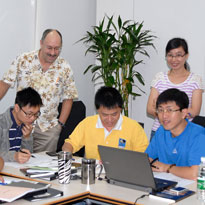Traffic Engineering – Multimedia Networks
- Course:Traffic Engineering – Multimedia Networks
- Course ID:TRAFFICMM Duration:2-4 days Where: Your Office (7+ Persons)
- Download Course Description (PDF)
Available as a private, customized course for your group at your offices or ours and in some cases as a WebLive(TM) class.
Course Outline
Day 1: Traffic Engineering Concepts
- Traffic Engineering Techniques
- Overview
- Circuit
- Cell
- Packet
- Switch/Router Issues
- Access and Admission
- Backbone
- Internetworking
- QoS/QoE Issues
- Traffic Distributions and Metrics
- Busy Hour Traffic (BHT) Measurement
- Busy Hour Call Attempts (BHCA)
- “Best Effort” Metrics
- Traffic Engineering Focus Points
- Access
- Backbone
- Interconnection
- Doing The Math
- Blocking Rates
- Grade of Service (GoS)
- Quality of Service (QoS)
- The Erlangs
- Erlang B
- Extended Erlang B Calculation (EEB)
- Equivalent Queue, Extended Erlang B (EQEEB)
- Erlang C
- Engest Calculation
- Poisson Calculation
- Binomial Calculation
- Provisioning
- Circuit/TDM
- Cell/ATM
- Packet/IP
- Internetworking
- Traffic Engineering Exercise
- Group and/or individual exercise: Engineering access and backbone for basic enterprise network environment. Objective is to size access for optimum QoS/QoE and price/cost trade-offs.
Day 2: Applying the Traffic Engineering Toolkit
- Multimedia
- Data Only
- Voice Only
- Video Only
- Data and Voice
- Data, Voice, and Video
- Services and Class of Service (CoS)
- Service Definitions
- Service Level Agreements (SLAs)
- Availability
- Packet Delivery
- Delay
- Delay Variation
- Service-Specific Metrics
- SLA Importance and Use
- QoS Portfolio
- Prioritization
- IP CoS / DiffServ (Differentiated Services)
- 802.1 p/q (LAN Switching Prioritization and VLAN)
- Weighted Fair Queuing/Class Based Weighted
- Fair Queueing (WFQ/CBWFQ)
- Low Latency Queueing (LLQ/DLLQ)
- Priority Queueing (PQ)
- Packet Fragmentation/Segmentation
- Frame Relay Priority PVCs and RTP Priority
- ATM CoS
- Intserv / RSVP (IP Reservation Protocol)
- Other Representative Techniques
- Bandwidth Reservation
- Bandwidth Reservation (VoDSL)
- TDM Bandwidth Reservation (Packet Cable)
- RSVP
- Route Optimization
- MPLS / gMPLS
- RSVP/RSVP-TE
- Hybrid(s)
- Prioritization
- Multimedia Traffic Engineering Exercise
Day 3: Hands-On Traffic Engineering
Automated network design and traffic engineering tools will be used in a “real world” scenario to model and simulate a multimedia IP network. The exercise will allow the participants to experiment on their own and run “what-if” type scenarios optimizing different aspects of network performance influenced by traffic engineering. Periodic milestones will be marked by group lab debriefs during which participants will share their ongoing progress. There are three levels of Hands-On Traffic Engineering labs geared to the experience and knowledge level of the learner. All learners will have a common debrief regardless of the level of difficulty of their lab exercise.
Course in a Nutshell
This course includes an intensive two-day long tutorial followed by a full day of workshop activity. You will begin by understanding the key concepts and techniques of traffic engineering. You will then learn to apply those techniques to the traffic engineering of QoS-aware multimedia networks. We will conclude with a day of exercises using actual network simulation tools. The exercises will be carefully chosen to reinforce what you learned in the first two days of the course.
To be able to participate in the hands-on activities, please bring a wireless-enabled laptop to the class. If using a company computer, please make sure beforehand that you have full administrative rights to install new software on the computer. The course relies heavily on instructor/class interaction and lab exercises to make sure that you get the most out of this class and can apply the material back on your job. So come prepared to ask questions and dig into the discussions and labs.
Customize It!
Customize this course to your exact requirements at little to no added cost. We can adjust the topics and level of details to suit your audience. Without the hands-on lab portion, the class can be shortened to two days. We can also expand the workshop to two days, for a four-day long course.
Learn How To
- Understand the concepts, math, and techniques of traffic engineering
- Determine the requirements for the various types of multimedia traffic
- Understand the difference between QoS and QoE
- Optimize the QoS and QoE for various traffic types
- Balance the requirements of real time and unidirectional data, audio and video
- Design for engineered networks vs big bandwidth networks
- Use real-time QoS and QoE measurements to provide a feedback loop for network performance improvement
Aimed At
Those designing, architecting, supporting, and planning QoS-aware multimedia wireless and wireline networks with an emphasis on the networks based on the Internet Protocol (IP).
Prerequisites
Solid understanding of circuit, cell and packet networking concepts and protocols, broadband networking, Quality of Service (QoS) and Quality of Experience (QoE), and at least two years experience designing and implementing networks.
- "Instructor is very passionate about the subject; liked ability to use examples on complex issues - made the class interesting. Especially liked the IP and network parts of the course. I learned a lot." – Communications Engineer, FLERS

